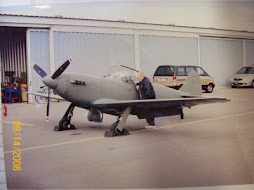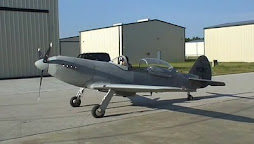Thanks for checking out the blog. This update is going to be dedicated to the seemingly never ending Hardinge CHNC lathe project. First off, a warning!
CAUTION ! - This update is completely dedicated to my work on this Hardinge CHNC Lathe projetct. There is no Prowler related material in this update. So, if you are only interested in Prowler "stuff" - you might want to skip ahead to other updates.
With that said, I will also say that some of the information in this update may have been mentioned in previous blog updates. My intention here is to go over some of the work that I have done to this machine that I did not want put in my normal Prowler updates. It's a lot of info, and I try to not "clutter up" the Prowler blog updates with too much non-Prowler related info.
Power Switch
One part of this project that I've not mentioned before is the power supply for the spindle system. After I moved all of the electrical components into the smaller compartment, I wanted to be able for the operator to turn it on from the front operator's station. So, I sourced an appropriate switch and a box and mounted them to the front of the machine. Here is what that turned out to look like:
F8025T Control Cooling
Another important change I made was adding ventilation to the F8025T. Heat is the enemy of every electrical component - I cannot believe that this control cabinet was not cooled in any way. Especially, considering that the Fagor control is in a box already - then whoever did this retrofit mounted that airtight box INISDE of another airtight box (you'll see it in few pics below). That's a formula for certain electronics failure! So, I found some fan screens and found an appropriate place to locate it:
Marked the mounting holes:
Then, cut air flow holes:
Test fit:
And, finally put it all together:
This setup in the back cabinet door was merely a vent for the fan air to exhaust out of the cabinet through. I created a similar vent on the bottom of the cabinet and mounted the fan on the inside above it: This allows the fan to blow directly up onto the control and then vent out the back of the outer control box. Here you can see the heat sink on the back of the actual control (computer) box that is mounted inside of the outer box (which holds the rest of the servo control components): This should help this F8025T last much longer - and the door won't have to hang open on the back of the control anymore!
RS232 Serial Connection
Here is another little facet of this project that has big returns. The connection for the serial cable that is used to hook the control to a laptop or PC was always laying inside the back door. I wanted to have this passing through the control wall so that it could could be connected to a PC without having to have the back door open. All that took was a drill bit, a small grommet and about an hour with a soldering iron to make it happen. Here was the final result:
In the next update you'll see how this serial cable is used to hook the control to a PC full time so that part files can be transfer to/from the control with ease.
Z Axis Homing Switch
Something else that was a pretty important part of this refurbish project was designing a new Z axis home switch. When the F8025T retrofit was done to this machine, they used one of the old limit switches that was original to the 1970's CHNC design. That switch finally became unusable (years of soaking in oil and coolant) and it was mounted in a difficult area to access. So, I wanted to move it to a more serviceable location and replace it with a new, reliable switch.
I sourced a good limit switch. But, there was no convenient place to locate it where a part of the cross-slide could contact the switch as needed to set the home position. So, I picked another convenient place to mount the switch and had to fabricate a long, rigid arm that would do the contact work:
Another view:
This Z homing setup works excellent now. It should provide reliable homing for many years. Seems like a simple thing, but the amount of work and time it takes to do these little things can really add up.
New X Axis Mechanical Setup
When I bought this project, the X axis servo motor and belt system was a cobbled together, hacked up mess. The main plate was not long enough to cover all the servo motor mounting bolts holes and an add-on plate was hacked away to allow for belt clearance. The 48 tooth cogged belt pulley was corroded and worn until the belt would skip and slip. All the this may not be clearly evident in this pic, but you'll get the idea:You can really see the bad condition of the big pulley here:
All that I really wanted to do with this was to find a 1-1/2" long piece of 48 tooth cogged bar so that I could machine it to fit the existing hardware, then make a new plate for mounting the servo to the X axis cross-slide and put it together. Well, it was not going to be that easy. I beat up the internet for days looking for a piece of 48 tooth stock - but all I could find were wholesale vendors that wanted to sell me a 10 foot bar of this stuff at a pretty hefty cost. That wasn't going to work.
Eventually, the best and most cost effective solution I could come up with was a retail pulley that I thought I might be able to adapt to the existing set up. So, I took the old part that you see on the left in the picture above and cleaned it up and shortened it a bit. Then, I put it back onto the machine:
Next, I had to machine a sleeve that would fit over the part above on the inside end, and fit the new pulley on the outside end. This is what I came up with, initially:
Then, I fitted the pulley onto the sleeve: After that, I started on the new servo motor mounting plate. Here it is, cut to size and shape and getting the hole cut in for the new pulley sleeve to pass through:
And, here is the test fit up:
Now, for the holes and slots to mount the servo motor:
Next, I had to make a sleeve to mount the small pulley to the servo motor shaft. Then, putting it all together got me to this:
This was looking and working great. But, I decided that the pulleys were sticking out too far. I took it all back apart and shortened the necessary pieces. Then, I put it all back together and now, it looked "right."This was much better. (You might notice that I also put a larger pulley on the servo motor shaft. I did that so that the servo shaft could pass all the way through the pulley and shorten the overall length. However, this required some re-programming of the control to account for the new gear ratio between the servo pulley and the X axis ballscrew.) Now, all that was left to do was make a cover to protect the belts and pulleys from coolant, etc. I'll cover that in the next update.
Spindle Electronics Cabinet Door
Here is a quick picture of the servo control cabinet after I fabricated and mounted a door to cover the components:






























No comments:
Post a Comment